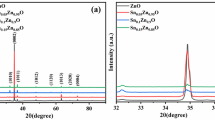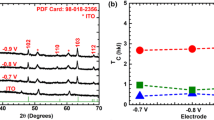Abstract
We report synthesis and characterization of ultrathin cobalt sulfide nanoflakes (CoSx-NFs) sensitized zinc oxide nanorods (Z-NRs) array based thin films and their implementation as photoanodes for photoelectrochemical (PEC) splitting of water. Cobalt sulfide nanoflakes-sensitized zinc oxide nanorods (CoSx-NFs/Z-NRs) array based photoanodes were grown on fluorine-doped tin oxide substrate by a simple and versatile electrodeposition method. Maximum conversion efficiency of PEC cell was found 0.37% with a photocurrent density of 0.48 mA/cm2 at a bias of 0.3 V/SCE in CoSx-NFs/Z-NRs-15 (loading of CoSx-NFs on Z-NRs by cyclic voltammetry for 15 cycles) based photoanodes. The photo-activity is 2.7 times larger than that of Z-NRs array-based photoanode. Experimental results reveal that sensitization by CoSx-NFs causes red shift in the band gap energy of Z-NRs photoanode. Lower band gap energy, suitable band redox potential, and marked absorption in visible light make CoSx-NFs/Z-NRs-15 thin films a promising material for photoanodes in PEC cells. A detailed analysis using X-ray diffraction (XRD), UV-Visible (UV-Visible) spectroscopy, field emission scanning electron microscope (FE-SEM), energy-dispersive analysis (EDX), electron impedance spectroscopy (EIS), Mott-Schottky (MS) analysis, applied bias photon-to-current conversion efficiency (ABPE), and incident photon to current conversion efficiency (IPCE) measurements has been carried out to substantiate our observations. The excellent performance of CoSx-NFs/Z-NRs allows the composite photoelectrode to have many potential applications as a photoanode material for H2 production, nanoflakes-sensitized solar cells, and UV photodetector.








Similar content being viewed by others
References
Li Z, Luo W, Zhang M, Feng J, Zou Z (2013) Photoelectrochemical cells for solar hydrogen production: current state of promising photoelectrodes, methods to improve their properties, and outlook. Energy Environ Sci 6:347–370
Ronge J, Bosserez T, Martel NC, Boarino L, Taulelle F, Decher G, Bordiga S, Martens JA (2014) Monolithic cells for solar fuels. Chem Soc Rev 43:7963–7981
Turner J, Sverdrup G, Mann MK, Maness PC, Kroposki B, Ghirardi M, Evans RJ, Blake D (2008) Renewable hydrogen production. Int J Energy Res 32:379–407
Fujishima A, Honda K (1972) Electrochemical photolysis of water at a semiconductor electrode. Nature 238:37–38
Nakataa K, Fujishima A (2012) TiO2 photocatalysis: design and applications. J Photochem Photobiol C: Photochem Rev 13:169–189
Bera A, Wu K, Sheikh A, Alarousu E, OF M, Wu T (2014) Perovskite oxide SrTiO3 as an efficient electron transporter for hybrid perovskite solar cells. J Phys Chem C 118:28494–28501
Yang W, Yu Y, Starr MB, Yin X, Li Z, Kvit A, Wang S, Zhao P, Wang X (2015) Ferroelectric polarization-enhanced photoelectrochemical water splitting in TiO2-BaTiO3 core-shell nanowire photoanodes. Nano Lett 15:7574–7580
Hu S, Shaner MR, Beardslee JA, Lichterman M, Brunschwig BS, Lewis NS (2014) Amorphous TiO2 coatings stabilize Si, GaAs, and GaP photoanodes for efficient water oxidation. Science 344:1005–1009
Gupta M, Sharma V, Shrivastava J, Solanki A, Singh AP, Satsangi VR, Dass S, Shrivastav R (2009) Preparation and characterization of nanostructured ZnO thin films for photoelectrochemical splitting of water. Bull Mater Sci 32:23–30
Wang M, Ren F, Zhou J, Cai G, Cai L, Hu Y, Wang D, Liu Y, Guo L, Shen S (2015) N doping to ZnO nanorods for photoelectrochemical water splitting under visible light: engineered impurity distribution and terraced band structure. Scientific Reports 5:12925–12938
Hsu YK, Lin YG, Chen YC (2011) Polarity-dependent photoelectrochemical activity in ZnO nanostructures for solar water splitting. Electrochem Commun 13:1383–1386
Chandiran AK, Abdi JM, Nazeeruddin MK, Gratzel M (2014) Analysis of electron transfer properties of ZnO and TiO2 photoanodes for dye-sensitized solar cells. ACS Nano 8:2261–2268
Jiang C, Moniz SJA, Khraisheh M, Tang J (2014) Earth-abundant oxygen evolution catalysts coupled onto ZnO nanowire arrays for efficient photoelectrochemical water cleavage. Chem Eur J 20:12954–12961
Wang C, Chen Z, Jin H, Cao C, Li J, Mi Z (2014) Enhancing visible-light photoelectrochemical water splitting through transition-metal doped TiO2 nanorod arrays. J Mater Chem A 2:17820–17827
Zhang X, Zhang B, Zuo Z, Wang M, Shen Y (2015) N/Si co-doped oriented single crystalline rutile TiO2 nanorods for photoelectrochemical water splitting. J Mater Chem A 3:10020–10025
Solanki A, Shrivastava J, Upadhyay S, Sharma V, Sharma P, Kumar P, Kumar P, Gaskell K, Satsangi VR, Shrivastav R, Dass S (2011) Irradiation-induced modifications and PEC response—a case study of SrTiO3 thin films irradiated by 120 MeV Ag9+ ions. Int J Hydrog Energy 36:5236–5245
Yang B, Fay P (2004) Etch rate and surface morphology control in photoelectrochemical etching of GaN. J Vac Sci Technol 22:1750–1754
Alibabaei L, Sherman BD, Norris MR, Brennaman MK, Meyer TJ (2015) Visible photoelectrochemical water splitting into H2 and O2 in a dye-sensitized photoelectrosynthesis cell. PNAS 112:5899–5902
Ren X, Sangle A, Zhang S, Yuan S, Zhao Y, Shi L, Hoye RLZ, Cho S, Li D, Driscoll JLM (2016) Photoelectrochemical water splitting strongly enhanced in fast-grown ZnO nanotree and nanocluster structures. J Mater Chem A 4:10203–10211
Petrella A, Cosma P, Curri ML, Rochira S, Agostiano A (2011) Colloidal nanocrystal ZnO-and TiO2-modified electrodes sensitized with chlorophyll a and carotenoids: a photoelectrochemical study. J Nanopart Res 13:6467–6481
Yi GC, Wang C, Park W (2005) ZnO nanorods: synthesis, characterization and application. Semicond Sci Technol 20:S22–S34
Cheng AJ, Tzeng Y, Zhou Y, Park M, Wu T, Shannon C, Wang D, Lee W (2008) Thermal chemical vapor deposition growth of zinc oxide nanostructures for dye sensitized solar cell fabrication. Appl Phys Lett 92:092113–092115
Montero MM, Pelaez RJ, Rico VJ, Saghi Z, Midgley P, Afonso CN, Elipe ARG, Borras A (2015) Laser treatment of Ag@ZnO nanorods as long-life-span SERS surfaces. Appl Mater Interfaces 7:2331–2339
Liu B, Zeng HC (2003) Hydrothermal synthesis of ZnO nanorods in the diameter regime of 50 nm. J Am Chem Soc 125:4430–4431
Sun Y, Fuge GM, Ashfold MNR (2006) Growth mechanisms for ZnO nanorods formed by pulsed laser deposition. Superlattice Microst 39:33–40
Pacholski C, Kornowski A, Weller H (2002) Self-assembly of ZnO: from nanodots to nanorods. Angew Chem 41:1188–1191
Lee JH, Ko KH, Park BO (2003) Electrical and optical properties of ZnO transparent conducting films by the sol-gel method. J Cryst Growth 247:119–125
Xu L, Guo Y, Liao Q, Zhang J, Xu D (2005) Morphological control of ZnO nanostructures by electrodeposition. J Phys Chem B 109:13519–13522
Skompska M, Zarebska K (2014) Electrodeposition of ZnO nanorod arrays on transparent conducting substrates—a review. Electrochim Acta 127:467–488
Kudo A, Miseki Y (2008) Heterogeneous photocatalyst materials for water splitting. Chem Soc Rev 38:253–278
Zhang K, Guo L (2013) Metal sulphide semiconductors for photocatalytic hydrogen production. Catal Sci Technol 3:1672–1690
Rokade A, Rondiya S, Sharma V, Prasad M, Pathan H, Jadkar S (2016) Electrochemical synthesis of 1D ZnO nanoarchitectures and their role in efficient photoelectrochemical splitting of water. J Solid State Electrochem. doi:10.1007/s10008-016-3427-9d
Miao J, Yang HB, Khoo SY, Liu B (2013) Electrochemical fabrication of ZnO/CdSe core-shell nanorod arrays for efficient photoelectrochemical water splitting. Nano 5:11118–11124
Tauc J, Grigorovici R, Vancu A Optical properties and electronic structure of amorphous germanium. Phys Status Solidi 15:627–637
Mora SI, Fabregat SF, Denier B, Bisquert J, Tena ZR, Elias J, Levy CC (2006) Determination of carrier density of ZnO nanowires by electrochemical techniques. Appl Phys Lett 89:203117–203119
Fabregat SF, Germa GB, Juan B, Peter B, Arie Z (2003) Mott-Schottky analysis of nanoporous semiconductor electrodes in dielectric state deposited on SnO2F conducting substrates. J Electrochem Soc 150:E293–E298
Chen Z, Jaramillo TF, Deutsch TG, Scwarsctein AK, Forman AJ, Gaillard N, Garland R, Takanabe K, Heske C, Sunkara M, Mcfarland EW, Domen K, Miller EL, Turner JA, Dinh HN (2010) Accelerating materials development for photoelectrochemical hydrogen production: standards for methods, definitions, and reporting protocols. J Mater Res 25:3–16
Mayabadi A, Pawbake A, Rondiya S, Rokade A, Waykar R, Jadhavar A, Date A, Sharma V, Prasad M, Pathan H, Jadkar S (2016) Synthesis, characterization, and photovoltaic properties of TiO2/CdTe core-shell heterostructure for semiconductor-sensitized solar cells (SSSCs). J Solid State Electrochem. doi:10.1007/s10008-016-3473-3
Acknowledgements
Mohit Prasad and Vidhika Sharma are thankful to the University Grants Commission, Government of India, New Delhi, for the Dr. D. S. Kothari Postdoc Fellowship. Avinash Rokade is thankful to the Ministry of New and Renewable Energy (MNRE), Govt. of India for the National Renewable Energy (NRE) fellowship. Sandesh Jadkar is thankful to UGC, New Delhi, for the special financial support under UPE program.
Author information
Authors and Affiliations
Corresponding authors
Rights and permissions
About this article
Cite this article
Prasad, M., Sharma, V., Rokade, A. et al. Enhanced photosplitting of water using ultrathin cobalt sulfide nanoflakes-sensitized zinc oxide nanorods array. Ionics 23, 3401–3408 (2017). https://doi.org/10.1007/s11581-017-2131-9
Received:
Revised:
Accepted:
Published:
Issue Date:
DOI: https://doi.org/10.1007/s11581-017-2131-9




